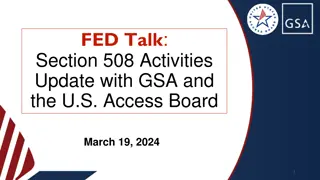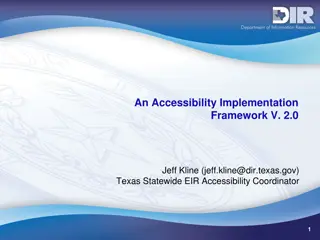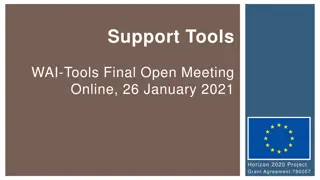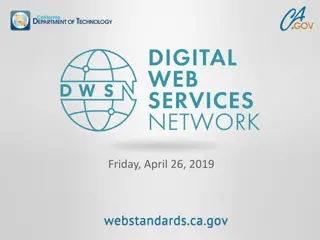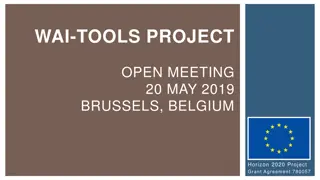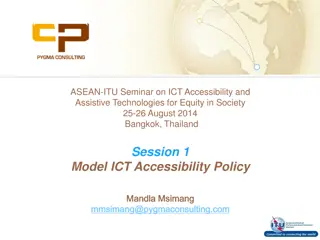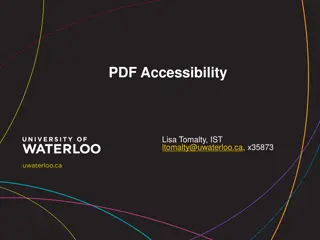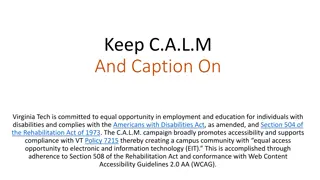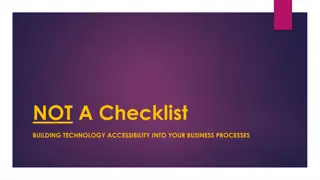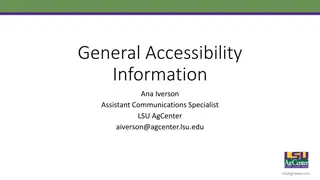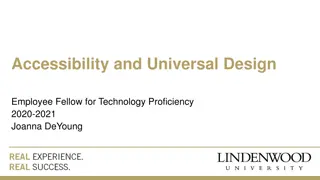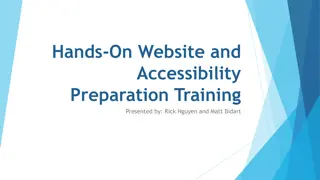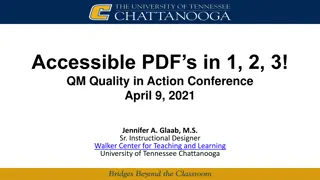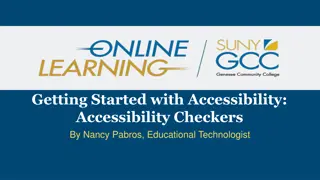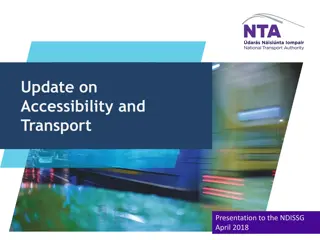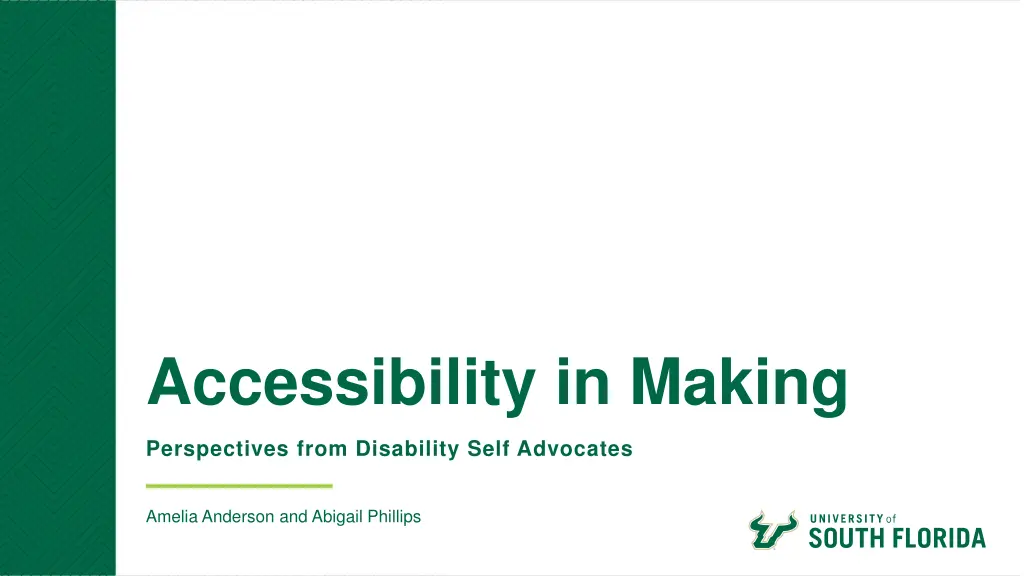
Improving Library Accessibility: Perspectives from Disability Self-Advocates
Delve into enhancing library accessibility through the insights of disability self-advocates. Learn about actionable steps to create inclusive and welcoming library spaces based on findings from a study funded by the Institute of Museum and Library Services (IMLS). Explore topics like reducing physical barriers, supporting technology use, and fostering community building. Gain valuable recommendations for enhancing public library spaces to cater to all community members effectively.
Download Presentation

Please find below an Image/Link to download the presentation.
The content on the website is provided AS IS for your information and personal use only. It may not be sold, licensed, or shared on other websites without obtaining consent from the author. If you encounter any issues during the download, it is possible that the publisher has removed the file from their server.
You are allowed to download the files provided on this website for personal or commercial use, subject to the condition that they are used lawfully. All files are the property of their respective owners.
The content on the website is provided AS IS for your information and personal use only. It may not be sold, licensed, or shared on other websites without obtaining consent from the author.
E N D
Presentation Transcript
Accessibility in Making Perspectives from Disability Self Advocates Amelia Anderson and Abigail Phillips
Overview In this session, we will discuss accessibility in library makerspaces. This session is based on the results from an Institute of Museum and Library Services (IMLS) grant, and we ll share with you the ways we gathered input. The disability community is unfortunately often overlooked when considering public library spaces, but this study sought their feedback to improve public spaces and services. By building more inclusive, diverse, and welcoming spaces, public libraries can meet the needs of all members of their community. We ll cover practical and impactful ways in which to improve library spaces. U N I V E R S I T Y O F S O U T H F L O R I D A
Outline Study Design Overview Background (or, why focus on accessibility in makerspaces?) How we recruited participants How we collected and analyzed data Recommendations for Practice Based on Findings To reduce physical barriers To minimize sensory concerns To support technology use To effectively share information To support learning activities and events To support community building U N I V E R S I T Y O F S O U T H F L O R I D A
Study Design: Background Disability Broadly Social Model of Disability Disability is multi-faceted; think about principles of Universal Design Disability in Public Libraries ASGCLA recommended incorporating UD Individual accommodations still must be made; disclosure can be an issue Inclusion and Disability in Makerspaces Makerspaces allow for tinkering in low-pressure environment Have shown potential in long-term care facilities contributing to residents senses of competence, autonomy, relatedness, and identity (Carucci & Toyama, 2019). Accessibility is a top priority, but it s not often built in U N I V E R S I T Y O F S O U T H F L O R I D A
Study Design: Data Collection Three groups of participants Advisory Board Pilot Test Options for participation Focus groups, interviews, survey Accessible practices built into data collection U N I V E R S I T Y O F S O U T H F L O R I D A
Study Design: Data Analysis Inductive and deductive coding Codes grouped into theme Themes shared with advisory board to establish transferability Member checks completed with participants U N I V E R S I T Y O F S O U T H F L O R I D A
Recommendations for Practice Based on Findings
To Reduce Physical Barriers o Place makerspace in a library location with accessible parking o Place makerspace in an easy-to-reach area of the library o Allow room for multiple wheelchairs to move around comfortably o Provide chairs and seating that accommodate all body sizes o Ensure that overhead power cords are the right height. Are they high enough that they are not a danger to patrons with low vision? Are they low enough that all can reach? o Ensure that cabinets and drawers are easy to open and reachable o Ensure that materials and projects are available for those who are unable to stand for extended periods of time o Ensure that materials and projects are available for those who have limb differences or use of only one hand o Provide items that are big enough for all to grasp and utilize, even those with limited fine motor control U N I V E R S I T Y O F S O U T H F L O R I D A
To Minimize Sensory Concerns o Reduce clutter and unnecessary visuals o Avoid timed lighting o Replace fluorescent lighting o Implement an air filtration system to mitigate smells from materials o Limit or ban use of materials with strong smells o Place makerspace in an area of the library away from other sensory distractions U N I V E R S I T Y O F S O U T H F L O R I D A
To Support Technology Use o Test technological programs for audio feedback and compatibility with JAWS o Provide an ergonomic mouse and keyboard for laptops; do not just rely on trackpads o Provide staff support for manipulating technology U N I V E R S I T Y O F S O U T H F L O R I D A
To Effectively Share Information o Provide instructions in multiple formats o Share information in advance when possible o Have clocks on the wall o Provide information about timing and schedules o Include messaging about availability of accommodations through signage and marketing materials U N I V E R S I T Y O F S O U T H F L O R I D A
To Support Learning Activities and Events o Complete projects prior to demonstrating them for patrons to identify potential barriers o Encourage multiple approaches for using tools and making o Be adaptable if something does not work as planned o Encourage questions and be approachable o Keep makerspace activities low pressure; don t introduce assessment or competition o Keep the focus on developing skills rather than completing a project o Limit attendance for programs and events o Avoid long events o Avoid packing many things into a scheduled event o Provide space for patrons during wait times between activities U N I V E R S I T Y O F S O U T H F L O R I D A
To Support Community Building o Provide opportunities for collaborative projects o Build inclusive practices into all making activities and events rather than providing disability friendly options U N I V E R S I T Y O F S O U T H F L O R I D A
Stay in Touch with Us: Amelia Anderson ameliaanderson@usf.edu Abigail Phillips abileigh@uwm.edu Assistant Professor USF Assistant Professor UWM-Milwaukee U N I V E R S I T Y O F S O U T H F L O R I D A

